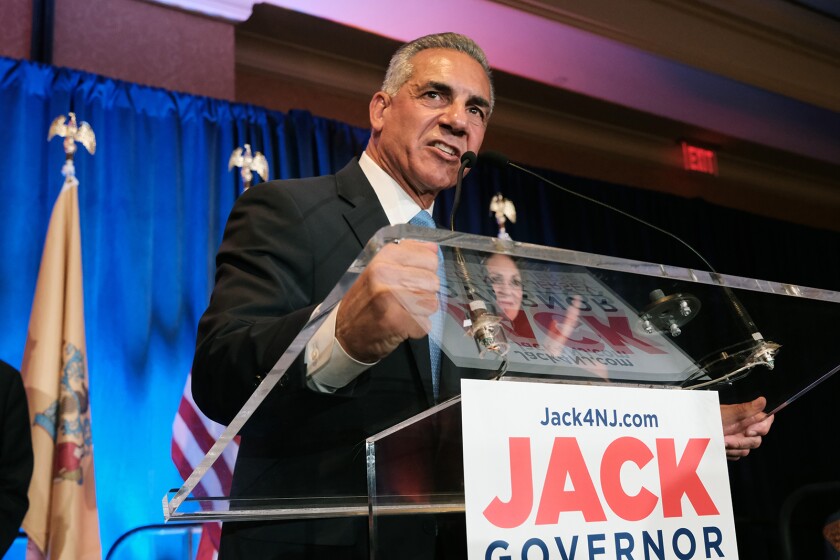The vibes are off at the National Governors Association.
Over the summer, Democratic governors Tim Walz of Minnesota and Laura Kelly of Kansas skipped the NGA’s biennial meeting, a critical and normally a unity-building event for the organization. They cited the NGA’s lack of urgency in responding to the Trump administration’s withholding of funds and politicization of federal grantmaking. More recently, Govs. JB Pritzker of Illinois and Gavin Newsom of California, also Democrats, said they’d leave the organization if it wouldn’t take a stand against Trump’s deployment of National Guard troops across state lines.
The Trump administration has ordered Texas troops to Illinois and California troops to Oregon to combat what he calls a crisis of urban crime, and to back up the operations of Immigration and Customs Enforcement officers in Chicago and Portland. Pritzker called that a violation of longstanding norms that give governors authority over National Guard troops, noting that all governors signed a letter last summer opposing a Biden administration plan to federalize some segments of the force. He called Texas Gov. Greg Abbott, a Republican who supported the deployments, “a tool of Donald Trump.”
The rupture was significant enough that NGA’s chair, Oklahoma Gov. Kevin Stitt, a Republican, felt compelled to speak up in defense of the governors who were threatening to leave, if not exactly in opposition to the Trump administration’s overarching goals. “We believe in the federalist system — that’s states’ rights,” he told the New York Times in a recent interview. “Oklahomans would lose their mind if Pritzker in Illinois sent troops down to Oklahoma during the Biden administration.”
Refereeing partisan fights like these is not how the National Governors Association likes to spend its time. Since 1908 the NGA has promoted bipartisan cooperation among state executives and helped to define and maintain a balance in federal-state relationships. The organization is led by governors — a chair and vice chair from opposite parties, with Republicans and Democrats alternating leadership each year. Federal lobbying on behalf of states and technical assistance with state legislation have always been part of NGA’s bid for legitimacy among its members. But bipartisanship itself — bipartisanship as a practice — has also been a top priority for the organization for decades.
“It was very collegial. People worked together and we found the common ground that we could,” says Ed Rendell, the former governor of Pennsylvania, a Democrat who chaired NGA in 2008 and 2009.
During Rendell’s time there he developed a friendship with Mitch Daniels, the Republican governor of Indiana, which was a benefit to both of their national reputations. They didn’t argue about what they didn’t agree on, Rendell says, and when both of them signed their names to a letter, “it had a lot more impact.” Friendships like those weren’t unheard of. Former Arkansas Gov. Mike Huckabee, a Republican, and former Iowa Gov. Tom Vilsack, a Democrat, ran a marathon together in 2005.
Part of NGA’s job is to promote the idea of “governors as governors first and Democrats or Republicans second,” says Raymond Scheppach, the executive director of the group from 1983 until 2011. Governors from both parties enjoy needling the federal government for its deficit spending, and noting that they’re required in most cases to sign a balanced annual budget. NGA chairs often lead their own campaigns. In Stitt’s case, it’s “Reigniting the American Dream.” For Utah Gov. Spencer Cox, who led NGA in 2023-2024, it was “Disagree better,” an effort to promote productive conversation across party lines.
The bipartisanship has always been partly for show. The governor of one state doesn’t have to agree on anything with the governor of another state in order to do their job. That lowers the stakes of their interactions. “Disagreeing better” is easy when it has no immediate consequences. And most state legislatures, which make the laws that governors sign, still have to punch and kick their way through bitter political fights year after year.
But there’s always been a genuine desire among state leaders to find common cause between opposing parties, however meager it may be. And it’s one of the only high-profile displays of bipartisanship in an increasingly divided country. Other associations — the National League of Cities, the National Association of Counties, the National Conference of State Legislatures — also convene elected officials from a range of political positions to pursue common goals. But those associations are focused more on providing technical assistance and sharing ideas between members, and less on promoting bipartisanship on a national stage.
As for the NGA as an organization, it’s survived lots of political pendulum swings in recent decades. Democrats had a majority of governors’ seats for much of the Ronald Reagan era, with as lopsided a margin as 35 to 15 in the mid-1980s. But Republicans have had the majority in all but four years since the early 1990s. The current split is 27 Republicans and 23 Democrats.
“I used to count. I could afford to have four wanting to fire me, but if I had five, you’ve got a problem,” Scheppach says of the NGA’s nine-member executive committee. “You’ve always pissed off two or three.”
Scheppach says NGA’s role as an influential lobbying group in Washington, D.C., is diminished from an earlier heyday. In the 1990s the association was actively involved in crafting federal policy on welfare and Medicaid. It wasn’t easy to forge a consensus or to stake out a specific stance on a policy issue. But when that happened, it carried a lot of weight. “If you can show the Congress that all parties agree on something, they’re fine. They’ll just go enact it,” Scheppach says.
Today, bipartisan common ground is shrinking evermore, even as some governors strive to keep the good vibes alive. It used to be an unwritten rule that governors wouldn’t publicly criticize one another, even if they were appearing at a campaign rally to support an opposing candidate. The debates playing out now, about whether troops can be sent from one state into another that doesn’t want them, are the biggest challenge to the organization’s sense of itself in decades. The departures of some members suggest it could take a long time to build back up.
“NGA is as good as the governors allow it to be,” says James Nash, a former spokesperson for the organization who now works in university communications in California. “As a membership organization, NGA needs its members to be active and engaged to fulfill its mission, which is incredibly important in our federalist system.”












